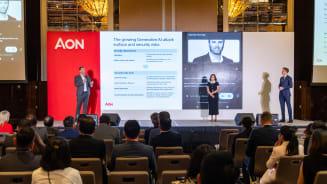The Role of Risk Management in the Age of Generative Artificial Intelligence

Artificial Intelligence (AI) has already begun to transform a range of industries. With the transformative potential to harness this new technology for improving efficiency, quality and business performance comes a new set of risks.
At our Aon Insights Series event in Singapore three of Aon’s leading cyber solutions specialists in Asia Pacific explored how risk professionals can take steps to engage with their stakeholders - from supply chain to insurance partners - to manage AI risks.
We have already seen significant financial losses when Generative AI is used to commit fraud. At the same time technology failures like the CrowdStrike outage have delivered widespread business disruption and economic damage . Highlighting the impacts that can cascade through a company’s operations and supply chain when a single critical technology fails.
For most companies the exploration and experimentation with new technologies, like Generative AI, is occurring at the ‘digital frontier’ of their operations which can be three to five years ahead of ‘business as usual’.
The Evolving Nature of AI Risk
The intersection of risks from sophisticated cyber threats and rapid adoption of AI can be grouped into three major categories:
1. Generative AI cyber-attacks
Threat actors are employing Generative AI to improve the efficacy and efficiency of hacking campaigns. Perhaps the most high-profile case to date is the use of Generative AI to impersonate a Chief Financial Officer and other executives on a video call to defraud a business out of USD$25 million. This is one example of how improper use of a likeness or voice can be used to commit a cybercrime, elevating the effectiveness of social engineering attacks. Threat actors are also employing Generative AI tools to bring speed and scale to the development of new malware tools. The development of WormGBT and FraudGBT are examples of how the advantages of Gen AI is being extended to organised crime.
2. Unsecure exploration of AI use cases
We expect a rise in cyber incidents that take full advantage of the rapid expansion of AI capabilities. This risk can be heightened by ‘shadow’ AI – AI use that hasn’t gone through the approved development processes or legal, compliance, and security checks. As companies try to keep up with their competitors and customer expectations, they are under pressure to fast-track innovation which can increase the risk of bypassing proper governance and risk mitigation. Resulting in an enlarged and unsecure digital attack surface that can be exploited by threat actors.
Approved AI use cases may also be targeted, including by data poisoning attacks where threat actors introduce malicious content into training data, such as profanity into a chatbot data set, or data extraction, where ‘adversarial’ prompts are used to get AI agents to disclose underlying data, unlocking valuable proprietary information and intellectual property as a result.
3. Unintended impacts of AI uptake
We are already seeing companies held liable for the actions of AI-powered chatbots and directors investigated for AI-related disclosures. This demonstrates that if organisations are harnessing AI, they need to be answerable for its performance. The presence of biases or inaccuracies can adversely impact a company’s reputation among stakeholders, from employees and clients to investors. Like the vulnerability of AI to malicious attack, this risk is also heightened when shadow AI is a widespread issue.
Risk leaders need to gain increased visibility across AI deployment within their organisation, working with their technology teams, suppliers and insurance partners. Armed with an awareness of the range of AI use cases and knowledge about the associated risks, they can then consider how existing coverage responds to those risks or where the company needs to find alternative solutions.
Three Ways for Risk Professionals to Engage on AI Risk
1. Engage with technology owners
Determining how insurance policies can tackle AI is on the agenda for risk leaders as they engage with stakeholders in the business. Risk leaders need to have a seat at the table with technology teams and other business units on current and planned uses of AI to map these to potential risks. Once they have this visibility from a risk perspective, there are many more stakeholders to inform and manage.
2. Engage with suppliers, vendors and insurance partners
For identified risks outside of shadow AI, there are a number of options for risk transfer, with suppliers and insurers being the chief stakeholders to work with. “For the time being, many companies will have what we call ‘silent’ AI cover, where conditions across a range of policies neither affirm nor exclude cover for their AI use cases,” says Andrew Mahony, Head of Cyber Solutions for Aon in Asia. “We recommend stress testing existing policies against your specific AI use case to determine whether risks and losses are transferable.”
The CrowdStrike incident demonstrated the importance of risk transfer across a company’s whole supply chain and technology ecosystem. “In some cases, CrowdStrike triggered cover under a direct business interruption loss,” Andrew says. “For others who were depending on businesses using CrowdStrike, they were looking to both their own contingent business interruption cover and contract terms with that supplier to determine liability for costs.”
For AI, companies should investigate how to transfer risk through contracts with certain service providers as well as organising their own risk transfer arrangements for losses that occur outside of their business boundary but within the business ecosystem.
A company’s visibility of their AI use cases and their frameworks around AI risk management will become increasingly relevant in the renewal discussions they are having across a range of insurance policy lines.
3. Engage with leadership
Risk leaders also need to engage with senior leaders to manage potential risks arising from the messaging delivered on progress with AI. “Just as we’ve seen with greenwashing, listed companies see commercial upsides in referencing AI in their public declarations, but this will come under scrutiny” says Andrew. “We are now seeing SEC enforcement actions and class actions in the US which is often where this exposure starts to emerge. Where businesses have been talking up AI capabilities with benefits for their share price, and those announcements are out of line with their actual deployment of the technology, they are now being held accountable.”
Visibility around AI use cases and the risks associated is critical for managing upwards. That work begins internally, but risk leaders should lean on trusted advisors to provide insights into peer experience and the application of existing and emerging risk transfer solutions.
General Disclaimer
This document is not intended to address any specific situation or to provide legal, regulatory, financial, or other advice. While care has been taken in the production of this document, Aon does not warrant, represent or guarantee the accuracy, adequacy, completeness or fitness for any purpose of the document or any part of it and can accept no liability for any loss incurred in any way by any person who may rely on it. Any recipient shall be responsible for the use to which it puts this document. This document has been compiled using information available to us up to its date of publication and is subject to any qualifications made in the document.
Terms of Use
The contents herein may not be reproduced, reused, reprinted or redistributed without the expressed written consent of Aon, unless otherwise authorized by Aon. To use information contained herein, please write to our team.
Aon's Better Being Podcast
Our Better Being podcast series, hosted by Aon Chief Wellbeing Officer Rachel Fellowes, explores wellbeing strategies and resilience. This season we cover human sustainability, kindness in the workplace, how to measure wellbeing, managing grief and more.
Aon Insights Series Asia
Expert Views on Today's Risk Capital and Human Capital Issues
Aon Insights Series Pacific
Expert Views on Today's Risk Capital and Human Capital Issues
Aon Insights Series UK
Expert Views on Today's Risk Capital and Human Capital Issues
Construction and Infrastructure
The construction industry is under pressure from interconnected risks and notable macroeconomic developments. Learn how your organization can benefit from construction insurance and risk management.
Cyber Labs
Stay in the loop on today's most pressing cyber security matters.
Cyber Resilience
Our Cyber Resilience collection gives you access to Aon’s latest insights on the evolving landscape of cyber threats and risk mitigation measures. Reach out to our experts to discuss how to make the right decisions to strengthen your organization’s cyber resilience.
Employee Wellbeing
Our Employee Wellbeing collection gives you access to the latest insights from Aon's human capital team. You can also reach out to the team at any time for assistance with your employee wellbeing needs.
Environmental, Social and Governance Insights
Explore Aon's latest environmental social and governance (ESG) insights.
Q4 2023 Global Insurance Market Insights
Our Global Insurance Market Insights highlight insurance market trends across pricing, capacity, underwriting, limits, deductibles and coverages.
Regional Results
How do the top risks on business leaders’ minds differ by region and how can these risks be mitigated? Explore the regional results to learn more.
Human Capital Analytics
Our Human Capital Analytics collection gives you access to the latest insights from Aon's human capital team. Contact us to learn how Aon’s analytics capabilities helps organizations make better workforce decisions.
Insights for HR
Explore our hand-picked insights for human resources professionals.
Workforce
Our Workforce Collection provides access to the latest insights from Aon’s Human Capital team on topics ranging from health and benefits, retirement and talent practices. You can reach out to our team at any time to learn how we can help address emerging workforce challenges.
Mergers and Acquisitions
Our Mergers and Acquisitions (M&A) collection gives you access to the latest insights from Aon's thought leaders to help dealmakers make better decisions. Explore our latest insights and reach out to the team at any time for assistance with transaction challenges and opportunities.
Navigating Volatility
How do businesses navigate their way through new forms of volatility and make decisions that protect and grow their organizations?
Parametric Insurance
Our Parametric Insurance Collection provides ways your organization can benefit from this simple, straightforward and fast-paying risk transfer solution. Reach out to learn how we can help you make better decisions to manage your catastrophe exposures and near-term volatility.
Pay Transparency and Equity
Our Pay Transparency and Equity collection gives you access to the latest insights from Aon's human capital team on topics ranging from pay equity to diversity, equity and inclusion. Contact us to learn how we can help your organization address these issues.
Property Risk Management
Forecasters are predicting an extremely active 2024 Atlantic hurricane season. Take measures to build resilience to mitigate risk for hurricane-prone properties.
Technology
Our Technology Collection provides access to the latest insights from Aon's thought leaders on navigating the evolving risks and opportunities of technology. Reach out to the team to learn how we can help you use technology to make better decisions for the future.
Top 10 Global Risks
Trade, technology, weather and workforce stability are the central forces in today’s risk landscape.
Trade
Our Trade Collection gives you access to the latest insights from Aon's thought leaders on navigating the evolving risks and opportunities for international business. Reach out to our team to understand how to make better decisions around macro trends and why they matter to businesses.
Weather
With a changing climate, organizations in all sectors will need to protect their people and physical assets, reduce their carbon footprint, and invest in new solutions to thrive. Our Weather Collection provides you with critical insights to be prepared.
Workforce Resilience
Our Workforce Resilience collection gives you access to the latest insights from Aon's Human Capital team. You can reach out to the team at any time for questions about how we can assess gaps and help build a more resilience workforce.
Explore more from our Aon Insights Series:
-

Article
The Next Evolution of Wellbeing is About Performance
Wellbeing programs should be part of an organizations culture to have an effect on engagement and performance. Read more how analytics lead to outcomes beyond health.
-

Article
4 Ways to Foster a Thriving Workforce Amid Rising Health Costs
Thriving organizations rely on thriving employees to succeed — and with healthcare costs on the rise, it’s time for employers to challenge the status quo in providing health benefits. Organizations need to consider the human side of these increases and take bold action to achieve better outcomes.
-

Article
Pay Transparency Can Lead to Better Equity Across Benefits
Efforts to bring more transparency to pay practices shine a light on benefits equity — and it’s not only about wages and salary.
















































































































































